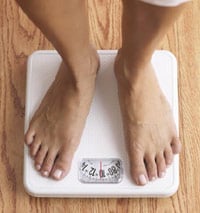With so many diet options to choose from it can be hard to find a weight loss plan that’s right for you.
To help, the British Dietetic Association (BDA) looks at the pros and cons and gives its verdict on the 10 most searched-for commercial diets.
Dukan diet
The Dukan diet is a low-carbohydrate (carb), high-protein diet.
There’s no limit to how much you can eat during the plan’s four phases,
providing you stick to the rules of the plan. During phase one, you’re
on a strict lean protein diet. This is based on a list of 72 reasonably
low-fat protein-rich foods, such as chicken, turkey, eggs, fish and
fat-free dairy. This is for an average of five days to achieve quick
weight loss. Carbs are off limits except for a small amount of oat bran.
Unlike the Atkins diet, Dukan’s phase one bans vegetables and seriously
restricts fat. The next three phases of the plan see the gradual
introduction of some fruit, veg and carbs and eventually all foods. The
aim is gradual weight loss of up to 2lb a week and to promote long-term
weight management. There’s no time limit to the final phase, which
involves having a protein-only day once a week and taking regular
exercise.
Pros:
You can lose weight very quickly, which can be motivating. It’s
a very strict and prescriptive diet and some people like that. It’s
easy to follow. You don’t need to weigh food or count calories. Apart
from keeping to low-fat, low-salt and high-protein foods, there’s no
restriction on how much you can eat during your first two weeks.
Cons:
At the start of the diet you may experience side effects such
as bad breath, a dry mouth, tiredness, dizziness, insomnia and nausea
from cutting out carbs. The lack of wholegrains, fruit and veg in the
early stages of the diet could cause problems such as constipation.
BDA verdict:
Rapid weight loss can be motivating but it is unsustainable and
unhealthy. The Dukan diet isn’t nutritionally balanced, which is
acknowledged by the fact that you need a vitamin supplement and a fibre
top up in the form of oat bran. There’s a danger this type of diet could
increase your risk of long-term health problems if you don’t stick to
the rules. The diet lacks variety in the initial phases so there’s a
risk you’ll get bored quickly and give up.
Atkins diet
The Atkins diet is a low-carb, high-protein weight loss programme.
You start with a low-carb diet designed for rapid weight loss. This
lasts at least two weeks depending on your weight loss goal. During this
phase, you’re on a protein, fat and very low-carb diet, including meat,
seafood, eggs, cheese, some veg, butter and oils. In contrast to the
Dukan diet, Atkins allows unlimited fat and some veg, such as peppers,
cucumber and iceberg lettuce, during phase one. During the next three
phases, the weight loss is likely to be more gradual, and regular
exercise is encouraged. More carbs, fruit and veg are introduced to your
diet with the aim of working out what your ideal carb intake is to
maintain a healthy weight for life. Phase one is designed to help you
lose up to 15lb in two weeks, reducing to 2lb to 3lb during phase two.
Pros:
You can lose weight very quickly, which can be motivating. The
diet also encourages people to cut out most processed carbs and alcohol.
With its diet of red meat, butter, cream, cheese and mayonnaise, it’s
one of the few diets out there that appeals to men.
Cons:
Initial side effects can include bad breath, a dry mouth,
tiredness, dizziness, insomnia, nausea and constipation from cutting out
carbs and fibre. The high intake of saturated fat may increase your
risk of heart disease
and there are concerns that a lack of fruit, veg and dairy products and
a high protein intake may affect bone and kidney health in the long
term.
BDA verdict:
Rapid weight loss can be motivating but it is unsustainable.
The Atkins diet isn’t nutritionally balanced. By limiting fruit and veg
it contradicts all the advice on healthy eating that we have tried so
hard to pass on to people. The meal choices are limited so there’s a
risk many people will get bored quickly and drop out or take a ‘pick and
mix’ approach.
Cambridge diet
The Cambridge Weight Plans are based around buying and eating a range
of meal-replacement products with the promise of rapid weight loss.
There are six flexible diet plans ranging from 415kcal to 1,500kcal or
more a day, depending on your weight loss goal. There is also a
long-term weight management programme. The bars, soups, porridges and
shakes can be used as your sole source of nutrition or together with
low-calorie regular meals. While on the programme, you receive advice
and support on healthy eating and exercise from a Cambridge adviser.
Pros:
Many people on very low-calorie diets (VLCDs)
find the weight loss to be sudden and quite dramatic. The meal
replacements are all nutritionally balanced so you're likely to be
getting all the vitamins and minerals you need albeit not from real
food.
Cons:
Initial side effects can include bad breath, a dry mouth,
tiredness, dizziness, insomnia, nausea and constipation from cutting
down on carbs and fibre. The hardest part of the plan is sticking to it.
Giving up normal meals and swapping them for a snack bar or a shake can
be boring and feel socially isolating. This isn’t a plan you can stick
to in the long term.
BDA verdict:
You need to like the meal-replacement products to stay with the
plan. Rapid weight loss can be motivating but it is unsustainable. A
VLCD that involves eating 1,000 calories a day or fewer should not be
followed for more than 12 continuous weeks. If you are eating fewer than
600 calories a day, you should have medical supervision.
South Beach Diet
The South Beach Diet is a low-GI diet
originally developed for heart patients in the US. There’s no calorie
counting and no limits on portions. You're encouraged to eat three meals
and two snacks a day and follow an exercise plan. People who have more
than 10lb to lose start with phase one. This is a two-week quick weight
loss regime where you eat lean protein, including meat, fish and
poultry, as well as some low-GI vegetables and unsaturated fats. Low-GI
carbs are re-introduced during phases two and three, which encourage
gradual and sustainable weight loss.
Pros:
If you can avoid phase one and start on phase two, there are
fewer dietary restrictions in the rest of the plan than some other
popular diets. After phase one, the diet broadly follows the basic
principles of healthy eating. No major food groups are eliminated and
plenty of fruit, veg and low-GI carbs are recommended.
Cons:
The severe dietary restrictions of phase one may leave you
feeling weak and missing out on some vitamins, minerals and fibre. You
may initially experience side effects such as bad breath, a dry mouth,
tiredness, dizziness, insomnia, nausea and constipation.
BDA verdict:
The first two weeks are the most difficult to get through.
We’re concerned that this diet promises such a large weight loss, up to
13lb, in the first two weeks. This, though, won't be all fat. Some of
the weight loss will include water and carbs - both of which will be
replaced when you begin eating more normally. Once you get past the
initial phase, the diet follows the basic principles of healthy eating
and should provide the nutrients you need to stay healthy.
Slimming World diet
Slimming World’s weight loss plan encourages you to swap high-fat
foods for low-fat foods that are naturally filling. You choose your food
from a list of low-fat foods they call 'Free Foods', such as fruit,
vegetables, pasta, potatoes, rice, lean meat, fish and eggs, which you
can eat in unlimited amounts. There’s no calorie counting, no foods are
banned and you’re still allowed the occasional treat. You can get
support from fellow slimmers at weekly group meetings and follow an
exercise plan to become gradually more active. The plan is designed to
help you lose about 1lb to 2lb a week.
Pros:
No foods are banned so meals offer balance and variety and are
family-friendly. The portion size from each food group will vary
depending which plan you follow. The 'Body Magic' booklet they provide
gives ideas to help you raise your activity levels. Meeting as a group
can provide valuable support.
Cons:
Slimming World doesn’t educate you about calories. Without
having learned about calories and portion sizes, you may struggle to
keep the weight off in the long term when you come off the programme.
BDA verdict:
The group meetings encourage members to share successes, ideas
and recipes with each other but they may not appeal to everyone. While
the meal plans may lack some flexibility, they are generally balanced.
However, without learning about calories and portion sizes, you may
struggle to make healthy choices once you’ve left the programme.
Slim-Fast diet
The Slim-Fast diet is a low-calorie meal replacement plan for people
with a BMI of 25 and over. It uses Slim-Fast’s range of products. The
plan recommends three snacks a day from an extensive list, including
crisps and chocolate, two meal replacement shakes or bars and one
regular meal, taken from a list of recipes on the Slim-Fast website. You
can stay on the diet for as long as you want depending on your weight
loss goal. Once reached, you’re advised to have one meal replacement
shake a day, up to two low-fat snacks and two healthy meals. The plan is
designed to help you lose about 1lb to 2lb a week and you can follow
the diet for as long as you want.
Pros:
Meal-replacement diets can be effective at helping some people
to lose weight and keep it off. The plan is convenient as the products
take the guesswork out of portion control and calorie counting. No foods
are forbidden although you are encouraged to eat lean protein, fruit
and vegetables.
Cons:
On their own, meal-replacement diets do little to educate
people about their eating habits and change their behaviour. There’s a
risk of putting the weight back on again once you stop using the
products. You may find it hard to get your 5 a day of fruit and veg without careful planning.
BDA verdict:
If you don’t like the taste of the meal replacement products,
you won't stay with the plan. The Slim-Fast plan can be useful to
kickstart your weight loss regime, but it’s important that you make full
use of the online support to learn about the principles of healthy
eating and how to manage everyday food and drink.
LighterLife diet
The LighterLife weight loss plans combine a very low-calorie
meal-replacement diet with weekly counselling. With LighterLife Total,
for people with a BMI of 30 or more, you eat four 'food packs' a day,
consisting of shakes, soups, mousses or bars, and no conventional food.
LighterLife Lite, for those with a BMI of 25-30, involves eating three
food packs a day plus one meal from a list of approved foods. You stay
on the plans until you reach your target weight. The meal plans can lead
to very rapid weight loss and you’re advised to see your GP before
starting. How long you stay on the diet depends on how much weight you
have to lose.
Pros:
The counselling can help you understand your relationship with
food, so hopefully you can make lasting changes to keep the weight off
for good. With the meal replacements, there’s no weighing or measuring,
so it’s a hassle-free approach to weight loss.
Cons:
Initial side effects of the diet can include bad breath, a dry
mouth, tiredness, dizziness, insomnia, nausea and constipation from
cutting down on carbs and fibre. Surviving on a strict diet of shakes
and soups and other meal replacements isn’t much fun and can feel
socially isolating.
BDA verdict:
Rapid weight loss can be motivating but it is unsustainable.
LighterLife’s VLCD and its counselling component may work for some,
particularly people who have struggled to lose weight for years, have
health problems as a result of their weight and are clinically obese
with a BMI of more than 30. A VLCD that involves eating 1,000 calories a
day or fewer should not be followed for more than 12 continuous weeks.
If you are eating fewer than 600 calories a day, you should have medical
supervision.
WeightWatchers diet
The WeightWatchers plan is based on the ProPoints system, which gives
a value to foods and drink based on protein, carbs, fat and fibre
content. It is essentially a calorie-controlled diet where you get a
personal daily ProPoints allowance, which you can use how you like.
There’s no limit on the amount of fruit and most veg you can eat. You
also get a weekly ProPoints safety net in case you go over your
allowance, and an individual exercise plan. The weekly meetings and
confidential weigh-ins provide support and extra motivation to encourage
long-term behaviour change. The plan is designed to help you lose up to
2lb a week.
Pros:
No foods are banned so you can eat and drink what you want
providing you stick to your points allowance. The ProPoints system is
easier to follow for some than calorie-counting and less restrictive
than other plans. This is because it introduces a safety net of points,
which can be saved up for a special occasion, such as a night out, a
small amount of alcohol or treats.
Cons:
When you begin, working out the points system can be just as
time consuming as simply counting calories. Some people feel pressured
into purchasing WeightWatchers branded foods.
BDA verdict:
The ProPoints plan is generally well balanced and can be a
foundation for long-term changes in dietary habits. The support group
approach can help keep people motivated and educate them about healthy
eating. But it’s vital that you make the connection between the points
system and calories if you want to avoid putting the weight back on once
you leave the programme.
Rosemary Conley diet
Rosemary Conley’s Diet and Fitness plans combine a low-fat, low-GI
diet with regular exercise. You can follow her recipes or buy from her
range of calorie-controlled ready meals and snacks. You’re encouraged to
eat food with 5% or less fat, with the exception of oily fish, porridge
oats and lean meat. A network of local Rosemary Conley clubs offers
weekly exercise classes, support and motivation. You learn about calorie
counting and portion size, which can help you sustain your weight loss
beyond the programme. The diet is designed to help you lose a stone in
seven weeks. How long you stay on the plan depends on your weight loss
goal.
Pros:
The programme is based around calories, with a focus on cutting
fat. The 'portion pots', which are used to measure foods such as rice,
cereal, pasta and baked beans, teach you about portion control. Physical
activity is an integral part of the weight loss plan, with exercise
sessions suitable for all ages, sizes and abilities offered at their
weekly classes with trained leaders.
Cons:
Some low-fat products aren't necessarily more healthy because they can
still be high in sugar and calories. It is unrealistic to expect people
to go out with their portion pots and, therefore, portion control may be
more tricky away from the home.
BDA verdict:
The diet and exercise plans offer a balanced approach to weight
loss that teaches you about portion size, the importance of regular
exercise for weight management and making healthier choices. The
educational element is very useful for long-term weight management once
you have left the programme.
Jenny Craig diet
The Jenny Craig programme has three main features: one-to-one
support, a meal delivery service and tailored exercise plans. The
weekly, personalised telephone consultations provide advice, motivation
and support. The diet adviser assesses your reasons for gaining weight
and, over the course of the programme, helps you to change your
behaviour. The meals and snacks are packed into single-sized portions to
suit your weight-loss needs. You need to add certain fresh fruits, veg
and low-fat dairy products. The programme is designed to help you lose
between 1lb and 2lb a week until you reach your target weight.
Pros:
All the meals, including snacks, are calorie-counted,
portion-controlled and delivered to your door. You eat real food,
receive telephone support and learn about portion size, calories and
exercise, which can all help you make healthier choices beyond the
programme.
Cons:
The meals don’t contain fruit, veg or dairy, which will be an
additional expense. This isn’t an approach that you can stick to in
the long term so it’s vital to learn how to prepare or choose healthy
food yourself rather than relying on someone else.
BDA verdict:
If you don’t like the Jenny Craig meals then this diet won’t
work for you. If you want a diet where most of the work is done for you
then the Jenny Craig programme can be a good solution. The concern with
pre-packaged meals is whether dieters will realise there is no magic
trick and be able to replicate the meals, with the same portion sizes
and calories, once they are on their own.
Article Source:
http://www.nhs.uk/Livewell/loseweight/Pages/top-10-most-popular-diets-review.aspx



 Look
for opportunities to reduce sedentary time and to increase active
time. For example, instead of watching TV, try taking a walk after
dinner.
Look
for opportunities to reduce sedentary time and to increase active
time. For example, instead of watching TV, try taking a walk after
dinner. 
 Follow a healthy and realistic eating pattern. You
have embarked on a healthier lifestyle, now the challenge is
maintaining the positive eating habits you've developed along the
way. In studies of people who have lost weight and kept it off for
at least a year, most continued to eat a diet lower in calories as
compared to their pre-weight loss diet.2
Follow a healthy and realistic eating pattern. You
have embarked on a healthier lifestyle, now the challenge is
maintaining the positive eating habits you've developed along the
way. In studies of people who have lost weight and kept it off for
at least a year, most continued to eat a diet lower in calories as
compared to their pre-weight loss diet.2 
 Get support from family, friends, and others.
People who have successfully lost weight and kept it off often rely
on support from others to help them stay on course and get over any
"bumps." Sometimes having a friend or partner who is also losing
weight or maintaining a weight loss can help you stay motivated.
Get support from family, friends, and others.
People who have successfully lost weight and kept it off often rely
on support from others to help them stay on course and get over any
"bumps." Sometimes having a friend or partner who is also losing
weight or maintaining a weight loss can help you stay motivated. 
 Reflect, Replace, Reinforce: A process for improving your eating habits
Reflect, Replace, Reinforce: A process for improving your eating habits Common triggers for eating when not hungry are:
Common triggers for eating when not hungry are: